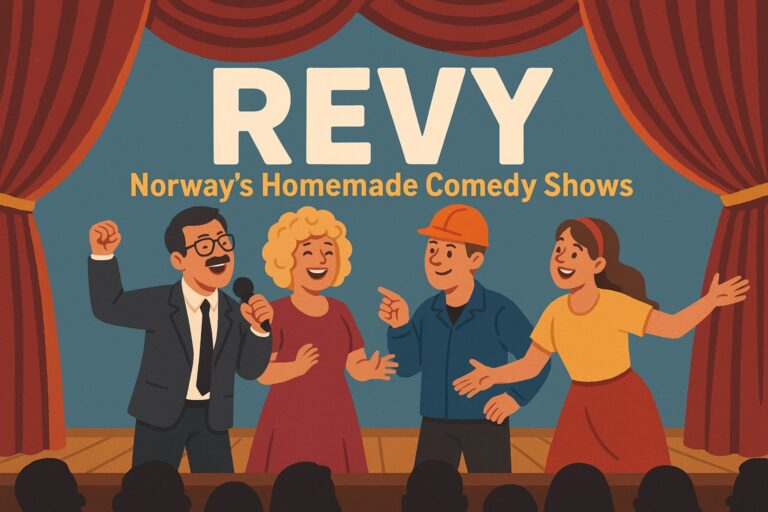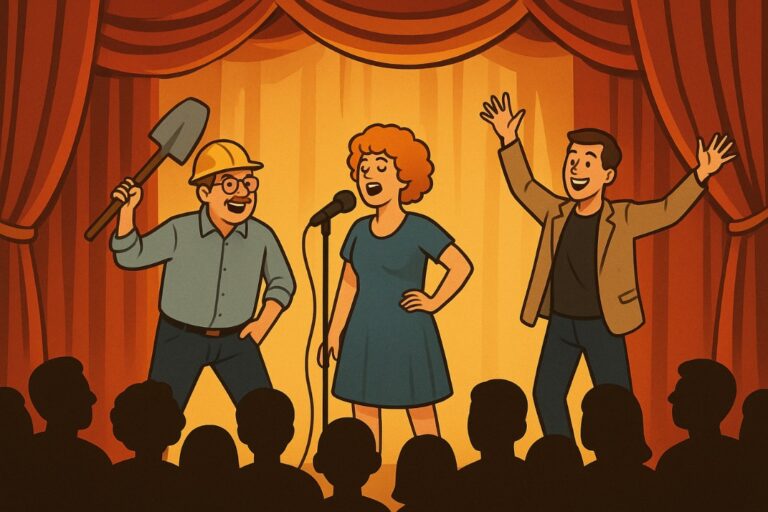Ever seen your high school teacher in a wig, singing a parody about local roadworks? In Norway, that’s not just a bizarre fantasy: it’s an actual possibility.
In towns big and small across Norway, groups of students, coworkers, and neighbours take to the stage each year with home-cooked comedy and self-made costumes.

It’s called revy, and it’s part sketch comedy, part musical, part local roast. You’ve got questions, I’m sure. Where did it all begin? And why is this still a big deal today? Stick around while we dim the light, raise the curtain, and start the show.
What is a ‘revy’ show?
Revy refers to a variety show mixing sketches, monologues and music, with the groups themselves known as revylag. Think Saturday Night Live, but with music, dance, and inside jokes about the local mayor.
When I first had the term explained to me, a short time after moving to Norway, it was in the context of someone telling me about an acquaintance participating in a revy show.
I was very impressed with the concept, and thought the acquaintance was a genius for coming up with it. What I discovered later is that revy isn’t some quirky one-off idea, it’s a long-standing tradition across Norway.
Every year, everyone from small-town neighbours and high-schoolers to university students and hospital staff team up to write, rehearse, and stage their own satirical variety show.
The history of ‘revy’
Norwegian revy has its roots in 19th century European vaudeville and French cabaret. The word revy comes from the French revue, meaning “review.”
By the late 1800s, this playful format had made its way to Oslo, where small-scale shows began poking fun at local society and politics.
Things really took off in the early 20th century. The opening of the ‘Chat Noir’ theatre in Oslo in 1912 marked the rise of professional revy, turning the genre into big-city entertainment.
Stars like Lalla Carlsen and Leif Juster helped make the genre the go-to comedy form of the interwar years. Over time, it absorbed new influences, keeping it fresh and deeply woven into Norwegian cultural life.
By the 1960s, revy wasn’t just for the professionals anymore. It had become a true national pastime.
What it’s like to see a Norwegian ‘revy' show
Going to a Norwegian revy show is a fun way to get insight into Norwegian culture while having a good laugh.

The obvious disadvantage for a foreigner is that the show will be in Norwegian. This difficulty is compounded by the fact that “getting the joke” in a foreign language is not always easy.
As if that wasn’t hard enough, the shows are focused on topical humour, for which you have to know a lot of context. So, unless you’re integrated into the local community, you’re almost guaranteed not to get a good portion of the humour.
But that’s not to say you won’t have a good time. Between the songs and dances, the physical comedy and the wide-context jokes about stuff you are bound to know if you know the language (national current events for example), there is something for everyone.
How to attend a ‘revy’ show
There are revy shows quite literally everywhere, so it shouldn’t be too difficult for you to find one.
Late winter is prime time: high-school and student revues dominate January to March, while many community troupes premiere in the dark weeks before Easter.
Programmes are advertised on Facebook pages such as “[Town] Revylag,” on the local kulturhus website or pinned to supermarket notice boards.
Don’t worry if your Norwegian is basic. Pick a larger student revy, as they tend to rely on visual gags and big musical numbers. If you can, bring a Norwegian friend who can whisper-translate key punchlines, or give you extra context afterwards, over a beer.
Feeling brave? Most groups welcome non-Norwegian speakers for crew roles, such as set-building, lighting, or ticket sales.
A national ‘revy’ championship
Revy is such a big deal across Norway that the country even has a national championship, held every other year as part of the Høylandet Revyfestival.
Since 1987, the festival has drawn thousands of spectators and amateur performers to a field in this tiny town in the middle of the country.
About 100 acts from all over Norway compete in semifinals across five categories, with only 20 advancing to the grand finale. Awards are handed out for best sketch, monologue, musical performance, delivery, writing, and the coveted “Number of the year”.
The event is part competition, part celebration, and helt toillåt (totally bonkers), as locals like to say. With nearly 10,000 in the audience, it’s clear that this homegrown tradition still knows how to draw a crowd.
Why ‘revy’ still matters
Ask Norwegians why they keep doing this and they’ll tell you about fellesskap: community. In sparsely populated regions, the annual revy is a social glue that pulls generations onto the same stage.
I’ve experienced this myself watching a show in Melhus, a small town located just south of Trondheim. Looking at the audience, you got a sense that this was a significant event in the community’s social calendar, one where their little community takes the centre stage… literally.
In bigger cities it’s a democratic equaliser: when the hospital’s chief surgeon has to deliver a power ballad while wearing fish-net tights, titles and hierarchies melt away. This is entirely in line with Norway’s tradition for flat-hierarchy.
Combine that with gentle political satire and you get something rare in modern life. This is a space where neighbours can laugh about the very issues they argued over on Facebook yesterday, then share coffee and waffles during intermission.
More than entertainment, revy is a yearly reminder that humour and teamwork can make even potholes and budget cuts feel bearable.
Is Norway’s ‘revy’ tradition unique?
Norway is not the only country with a healthy amateur theatre community. Across the world, people gather to write, rehearse, and perform for local audiences. But there is something distinctive about the way Norwegians do it.
Take the United Kingdom, for example. Student groups like the Cambridge Footlights have launched major comedy careers, and local theatre groups across Britain keep the tradition of community pantomimes alive each Christmas.
Pantomimes are full of energy and community spirit, but they tend to lean on classic plots instead of a succession of separate numbers related to current events.
They are also notorious for involving the audience directly. That’s a component not usually present in Norwegian revy.
In the United States, amateur theatre is widespread, with thousands of community groups staging musicals and plays. Sketch comedy thrives too, though mostly through professional troupes or college clubs.
What’s less common is the kind of hyper-local, satirical performance you’ll find in a Norwegian village hall. It’s a show that pokes fun at municipal politics, neighbourhood gossip, and national headlines all at once.
Even in neighbouring Sweden and Denmark, similar student and community groups exist, but few countries match the reach of Norway’s revy tradition.

